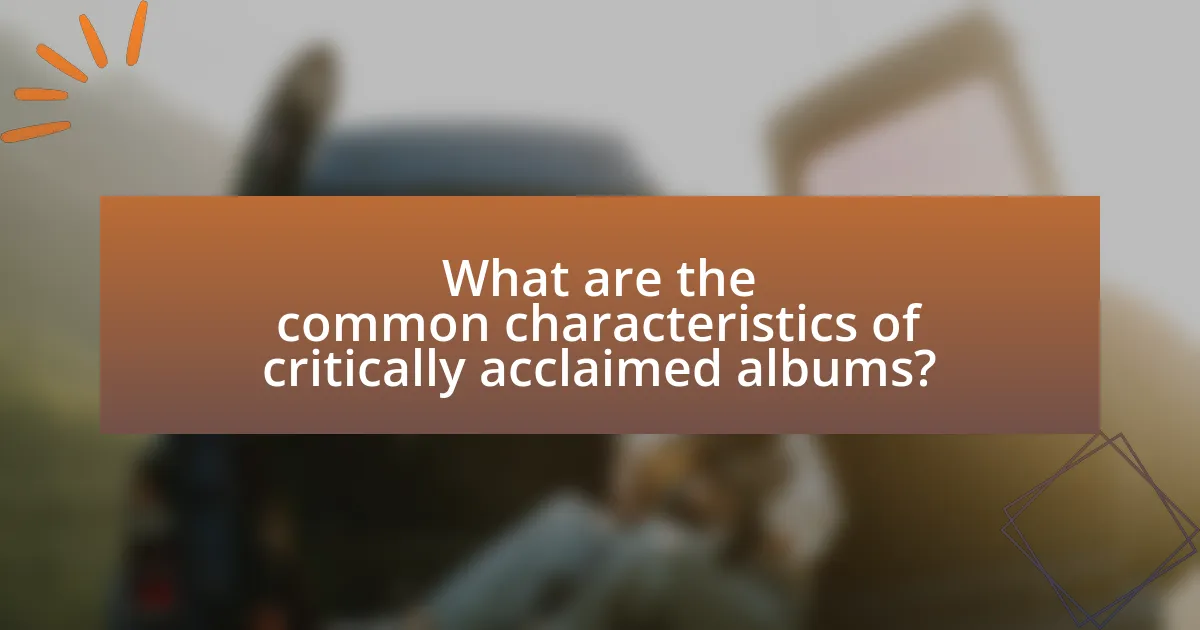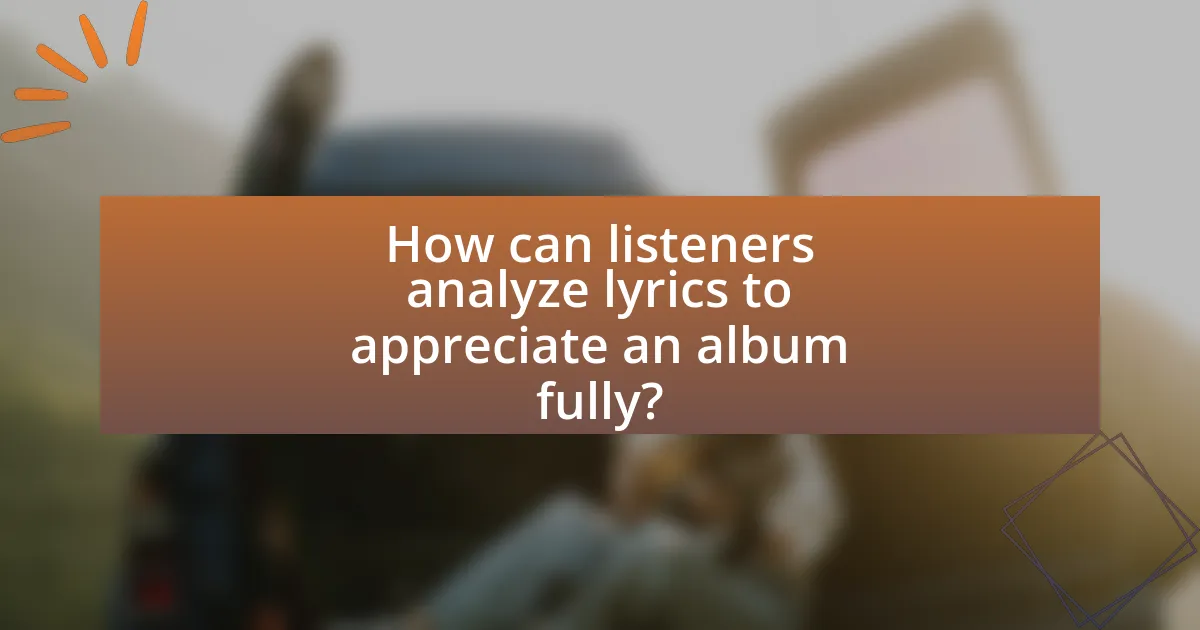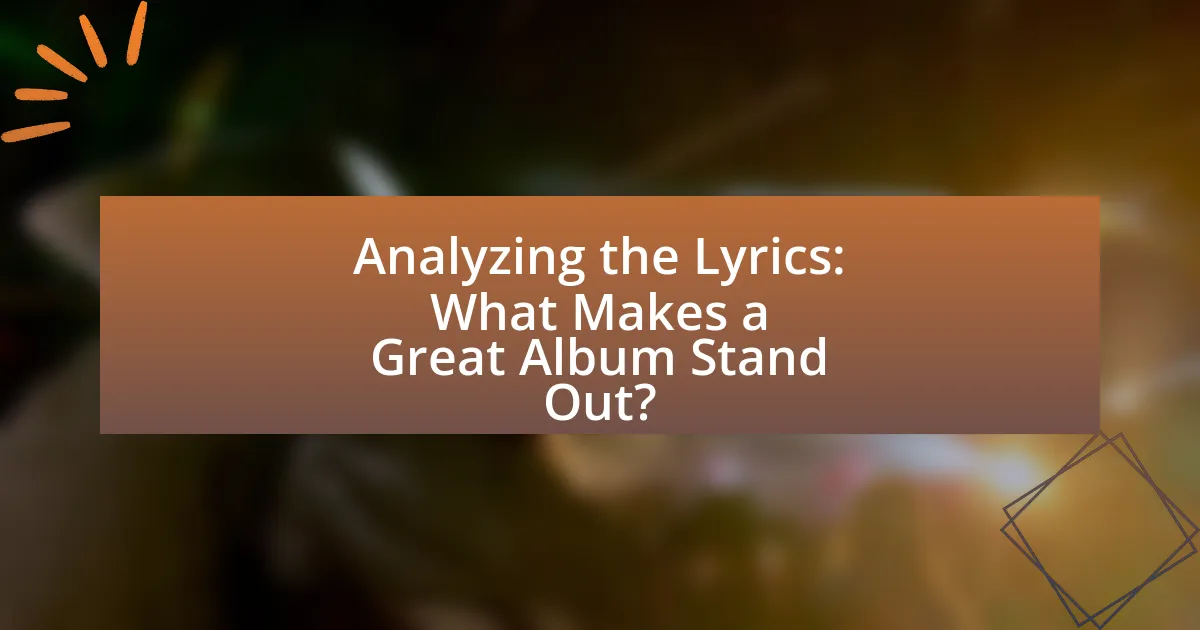The article “Analyzing the Lyrics: What Makes a Great Album Stand Out?” examines the essential elements that contribute to impactful album lyrics, including emotional depth, originality, storytelling, and relatability. It discusses how lyrical themes shape listener engagement and the significance of personal experiences in crafting relatable narratives. The article also explores the role of songwriting techniques, metaphors, and song structure in enhancing lyrical effectiveness, as well as the importance of vocal delivery and production elements. Additionally, it highlights the value of collaboration in songwriting and provides strategies for listeners to analyze lyrics for a deeper appreciation of music.
What are the key elements that make an album’s lyrics stand out?
The key elements that make an album’s lyrics stand out include emotional depth, originality, storytelling, and relatability. Emotional depth allows listeners to connect with the artist’s feelings, while originality ensures that the lyrics offer a fresh perspective or unique expression. Storytelling engages the audience by weaving narratives that captivate and resonate, and relatability makes the themes accessible to a broad audience. For instance, albums like “The Miseducation of Lauryn Hill” showcase these elements through personal narratives and universal themes, contributing to their lasting impact and critical acclaim.
How do lyrical themes contribute to an album’s impact?
Lyrical themes significantly contribute to an album’s impact by shaping the emotional and intellectual connection listeners have with the music. When an album explores relatable themes such as love, loss, or social issues, it resonates more deeply with audiences, enhancing their overall experience. For instance, albums like “The Wall” by Pink Floyd address themes of isolation and mental health, which have led to critical acclaim and lasting influence in music history. This connection can drive album sales, streaming numbers, and cultural relevance, demonstrating that well-crafted lyrical themes are essential for an album’s success and longevity.
What common themes resonate with listeners in great albums?
Common themes that resonate with listeners in great albums include love, loss, identity, and social issues. These themes often evoke strong emotional responses, making the music relatable and impactful. For instance, albums like “Rumours” by Fleetwood Mac explore complex relationships and heartbreak, while Kendrick Lamar’s “To Pimp a Butterfly” addresses racial identity and social justice. Such thematic depth allows listeners to connect personally with the music, enhancing their overall experience and engagement with the album.
How do personal experiences shape lyrical themes?
Personal experiences significantly shape lyrical themes by providing authentic emotional content and relatable narratives. Artists often draw from their own life events, such as relationships, struggles, and triumphs, to create lyrics that resonate with listeners. For instance, Taylor Swift’s songwriting frequently reflects her personal experiences with love and heartbreak, allowing her audience to connect deeply with her music. This connection is supported by research indicating that songs based on personal experiences tend to evoke stronger emotional responses from listeners, enhancing the overall impact of the album.
In what ways do songwriting techniques enhance lyrics?
Songwriting techniques enhance lyrics by providing structure, emotional depth, and thematic coherence. Techniques such as rhyme schemes, meter, and repetition create a memorable flow that engages listeners. For instance, the use of a consistent rhyme scheme can make lyrics more catchy and easier to remember, as seen in popular songs like “Hey Jude” by The Beatles, which employs a simple yet effective structure. Additionally, techniques like metaphor and imagery enrich the emotional resonance of lyrics, allowing artists to convey complex feelings succinctly. For example, Bob Dylan’s use of vivid imagery in “Blowin’ in the Wind” evokes strong emotional responses and deepens the listener’s connection to the message. Furthermore, the incorporation of storytelling elements in songwriting can enhance narrative clarity, making the lyrics more relatable and impactful, as demonstrated in Taylor Swift’s storytelling approach in songs like “The Last Great American Dynasty.” These techniques collectively contribute to the overall effectiveness and memorability of lyrics, making them stand out in the music landscape.
What role do metaphors and similes play in effective lyrics?
Metaphors and similes enhance effective lyrics by creating vivid imagery and emotional resonance. These literary devices allow songwriters to convey complex ideas and feelings in a relatable manner, making the lyrics more engaging and memorable. For instance, Bob Dylan’s use of metaphors in “Blowin’ in the Wind” deepens the listener’s understanding of social issues, while similes in Taylor Swift’s “Love Story” evoke strong emotions by comparing love to timeless narratives. Research indicates that songs with rich figurative language tend to have higher listener retention and emotional impact, demonstrating the importance of these devices in crafting compelling lyrics.
How does the structure of a song influence its lyrical effectiveness?
The structure of a song significantly influences its lyrical effectiveness by providing a framework that enhances the delivery and emotional impact of the lyrics. A well-defined structure, such as verses, choruses, and bridges, allows for a clear progression of ideas and emotions, making it easier for listeners to connect with the message. For instance, the repetition found in choruses reinforces key themes, while verses can explore narratives or emotions in depth, creating a dynamic interplay that captivates the audience. Research indicates that songs with a strong structural foundation tend to have higher listener engagement, as the predictability of structure can evoke familiarity and comfort, allowing the lyrics to resonate more profoundly.
Why is the emotional connection between lyrics and listeners important?
The emotional connection between lyrics and listeners is important because it enhances the overall impact of the music, fostering a deeper engagement and resonance with the audience. This connection allows listeners to relate personal experiences to the themes expressed in the lyrics, creating a sense of shared understanding and empathy. Research indicates that songs with relatable emotional content can lead to increased listener satisfaction and loyalty, as evidenced by a study published in the Journal of Consumer Research, which found that emotionally charged music can evoke strong memories and feelings, reinforcing the bond between the artist and the audience.
How do artists evoke emotions through their lyrics?
Artists evoke emotions through their lyrics by utilizing vivid imagery, relatable themes, and personal storytelling. These techniques allow listeners to connect deeply with the music, as lyrics often reflect universal human experiences such as love, loss, and struggle. For instance, artists like Adele and Bob Dylan employ specific language and metaphors that resonate with listeners’ feelings, creating a powerful emotional response. Research indicates that lyrics that incorporate personal anecdotes or emotional vulnerability can significantly enhance listener engagement and empathy, as demonstrated in studies on music psychology.
What impact does storytelling have on listener engagement?
Storytelling significantly enhances listener engagement by creating emotional connections and fostering empathy. When narratives are woven into music, they allow listeners to relate personally to the themes and characters, making the experience more immersive. Research indicates that songs with strong storytelling elements can increase listener retention and emotional response, as evidenced by a study published in the Journal of Consumer Research, which found that narratives in advertising led to higher engagement levels compared to non-narrative formats. This demonstrates that storytelling not only captivates audiences but also deepens their connection to the music, ultimately making albums more memorable and impactful.
How do production elements complement lyrical content?
Production elements enhance lyrical content by creating an emotional backdrop that amplifies the message conveyed in the lyrics. For instance, the use of instrumentation, tempo, and dynamics can evoke specific feelings that align with the themes of the lyrics. A study by the University of Southern California found that songs with strong production elements, such as rich harmonies and varied textures, significantly impact listeners’ emotional responses, thereby reinforcing the lyrical narrative. This synergy between production and lyrics is evident in genres like hip-hop and pop, where beats and melodies are crafted to complement the storytelling aspect of the lyrics, making the overall experience more immersive and impactful.
What role does vocal delivery play in the perception of lyrics?
Vocal delivery significantly influences the perception of lyrics by shaping emotional resonance and interpretative meaning. The way a vocalist articulates words, including tone, pitch, and rhythm, can evoke specific feelings and enhance the listener’s connection to the song. For instance, a study published in the Journal of Experimental Psychology found that variations in vocal expression can alter listeners’ emotional responses to the lyrics, demonstrating that delivery can amplify or diminish the intended message. Thus, effective vocal delivery not only conveys the lyrical content but also enriches the overall listening experience by aligning the emotional tone with the song’s themes.

What are the common characteristics of critically acclaimed albums?
Critically acclaimed albums typically exhibit strong songwriting, innovative production, and emotional depth. Strong songwriting is characterized by well-crafted lyrics that resonate with listeners, often addressing universal themes or personal experiences. Innovative production involves unique soundscapes and arrangements that push musical boundaries, as seen in albums like “OK Computer” by Radiohead, which blends rock with electronic elements. Emotional depth is reflected in the ability of the album to evoke feelings and connect with audiences on a personal level, exemplified by “To Pimp a Butterfly” by Kendrick Lamar, which tackles complex social issues and personal struggles. These characteristics contribute to the overall impact and lasting significance of critically acclaimed albums in the music industry.
How do innovative lyrics differentiate an album from its peers?
Innovative lyrics differentiate an album from its peers by introducing unique themes, storytelling techniques, and linguistic creativity that resonate with listeners on a deeper level. For instance, albums like Bob Dylan’s “Highway 61 Revisited” revolutionized songwriting by blending poetic imagery with social commentary, setting a new standard for lyrical depth in music. This distinctiveness not only captures audience attention but also fosters emotional connections, making the album memorable and influential compared to others in the same genre.
What examples illustrate innovation in lyrical content?
Examples that illustrate innovation in lyrical content include Bob Dylan’s “Subterranean Homesick Blues,” which introduced stream-of-consciousness writing and social commentary in popular music. Another example is Kendrick Lamar’s “To Pimp a Butterfly,” which blends personal narrative with broader themes of race and identity, utilizing complex metaphors and non-linear storytelling. Additionally, Fiona Apple’s “Fetch the Bolt Cutters” showcases innovative structure and raw emotional honesty, breaking traditional song formats. These examples demonstrate how artists push boundaries in lyrical expression, reflecting societal issues and personal experiences in unique ways.
How does cultural context influence lyrical innovation?
Cultural context significantly influences lyrical innovation by shaping the themes, language, and emotional resonance of lyrics. For instance, artists often draw from their cultural backgrounds, societal issues, and historical events to create lyrics that reflect their experiences and perspectives. This is evident in genres like hip-hop, where artists address social justice, identity, and community struggles, leading to innovative lyrical expressions that resonate with listeners. A concrete example is Kendrick Lamar’s album “To Pimp a Butterfly,” which incorporates elements of African American culture and history, resulting in groundbreaking lyrical content that challenges societal norms. Thus, cultural context not only informs the subject matter of lyrics but also drives the evolution of lyrical styles and techniques, making them more relevant and impactful.
What is the significance of collaboration in songwriting?
Collaboration in songwriting is significant because it combines diverse perspectives and skills, enhancing creativity and innovation. When songwriters collaborate, they can merge different musical styles, lyrical themes, and emotional insights, resulting in richer and more complex songs. For instance, many successful songs have emerged from partnerships, such as the collaboration between John Lennon and Paul McCartney, which produced numerous iconic tracks. This synergy often leads to a more polished final product, as collaborators can provide constructive feedback and refine each other’s ideas, ultimately contributing to the overall quality of an album.
How do collaborations enhance lyrical depth?
Collaborations enhance lyrical depth by combining diverse perspectives and experiences, which enriches the thematic complexity of the lyrics. When artists from different backgrounds collaborate, they bring unique storytelling techniques and emotional insights, resulting in a more nuanced narrative. For example, the collaboration between Jay-Z and Alicia Keys on “Empire State of Mind” merges hip-hop and R&B, creating a multifaceted portrayal of New York City that resonates with a broader audience. This blending of styles and viewpoints allows for a deeper exploration of themes, making the lyrics more relatable and impactful.
What are some notable collaborations that resulted in standout lyrics?
Notable collaborations that resulted in standout lyrics include “Empire State of Mind” by Jay-Z and Alicia Keys, which captures the essence of New York City through vivid imagery and personal storytelling. Another example is “Love Me” by Lil Wayne, Eminem, and Drake, where each artist contributes unique perspectives, creating a dynamic lyrical interplay. Additionally, “See You Again” by Wiz Khalifa featuring Charlie Puth stands out for its emotional depth and poignant themes of loss and remembrance. These collaborations exemplify how combining distinct voices can enhance lyrical impact and resonate with audiences.

How can listeners analyze lyrics to appreciate an album fully?
Listeners can analyze lyrics by examining themes, literary devices, and the emotional context to fully appreciate an album. By identifying recurring motifs and messages, listeners gain insight into the artist’s intent and the narrative structure of the album. For instance, analyzing the use of metaphors, similes, and imagery can reveal deeper meanings and enhance the listening experience. Additionally, understanding the historical and cultural background of the lyrics can provide context that enriches interpretation. Research indicates that engaging with lyrics in this manner can lead to a more profound emotional connection with the music, as evidenced by studies showing that active listening improves appreciation and retention of musical content.
What techniques can listeners use to dissect lyrics effectively?
Listeners can use techniques such as thematic analysis, lyrical breakdown, and contextual interpretation to dissect lyrics effectively. Thematic analysis involves identifying recurring themes or messages within the lyrics, which helps listeners understand the overarching narrative or emotional tone of the song. Lyrical breakdown entails examining individual lines or verses for literary devices, such as metaphors, similes, and rhyme schemes, which can reveal deeper meanings and artistic intentions. Contextual interpretation requires considering the historical, cultural, or personal background of the artist and the song, providing insight into the motivations behind the lyrics. These techniques enhance comprehension and appreciation of the music, allowing listeners to engage more deeply with the content.
How can understanding an artist’s background enhance lyrical analysis?
Understanding an artist’s background enhances lyrical analysis by providing context that informs the themes, emotions, and perspectives expressed in their work. For instance, an artist’s cultural heritage, personal experiences, and socio-economic status can shape their lyrical content, allowing listeners to grasp deeper meanings. Research indicates that artists often draw from their life experiences to create relatable narratives, as seen in the works of artists like Kendrick Lamar, whose lyrics reflect his upbringing in Compton, California, and address issues such as systemic racism and personal struggle. This contextual knowledge enables a more nuanced interpretation of the lyrics, revealing layers of significance that might otherwise be overlooked.
What resources are available for deeper lyrical analysis?
Resources for deeper lyrical analysis include academic journals, books on music theory and lyric interpretation, online databases, and lyric analysis websites. Academic journals such as “Popular Music” and “Journal of Popular Music Studies” provide peer-reviewed articles that explore various aspects of lyrics and their cultural significance. Books like “Lyrics: A New Approach” by David A. J. Richards offer insights into the techniques used in songwriting. Online databases such as JSTOR and Google Scholar allow access to a wide range of scholarly articles on lyrical analysis. Additionally, websites like Genius provide annotations and interpretations of song lyrics, enhancing understanding through community contributions and expert insights. These resources collectively support a comprehensive approach to analyzing lyrics in the context of music.
What are some tips for identifying standout lyrics in an album?
To identify standout lyrics in an album, focus on themes, emotional resonance, and unique wordplay. Themes that resonate with listeners often highlight universal experiences, making them memorable. Emotional resonance can be gauged by how the lyrics evoke feelings or connect with personal experiences, as seen in tracks like “Hallelujah” by Leonard Cohen, which captures deep sorrow and longing. Unique wordplay, such as clever metaphors or unexpected rhymes, can also elevate lyrics, as demonstrated in “Lose Yourself” by Eminem, where intricate language enhances the message. Analyzing these elements helps pinpoint lyrics that leave a lasting impact.
How can listeners apply their insights to enhance their music experience?
Listeners can apply their insights by actively analyzing lyrics and understanding the themes and emotions conveyed in the music. This deeper engagement allows listeners to connect more profoundly with the artist’s intent and the overall message of the album. Research indicates that active listening, which includes focusing on lyrics and their meanings, enhances emotional responses and personal connections to music, leading to a more enriching experience. For instance, a study published in the Journal of Music Therapy found that individuals who engaged in lyrical analysis reported higher levels of emotional satisfaction and personal relevance in their music listening experiences.
